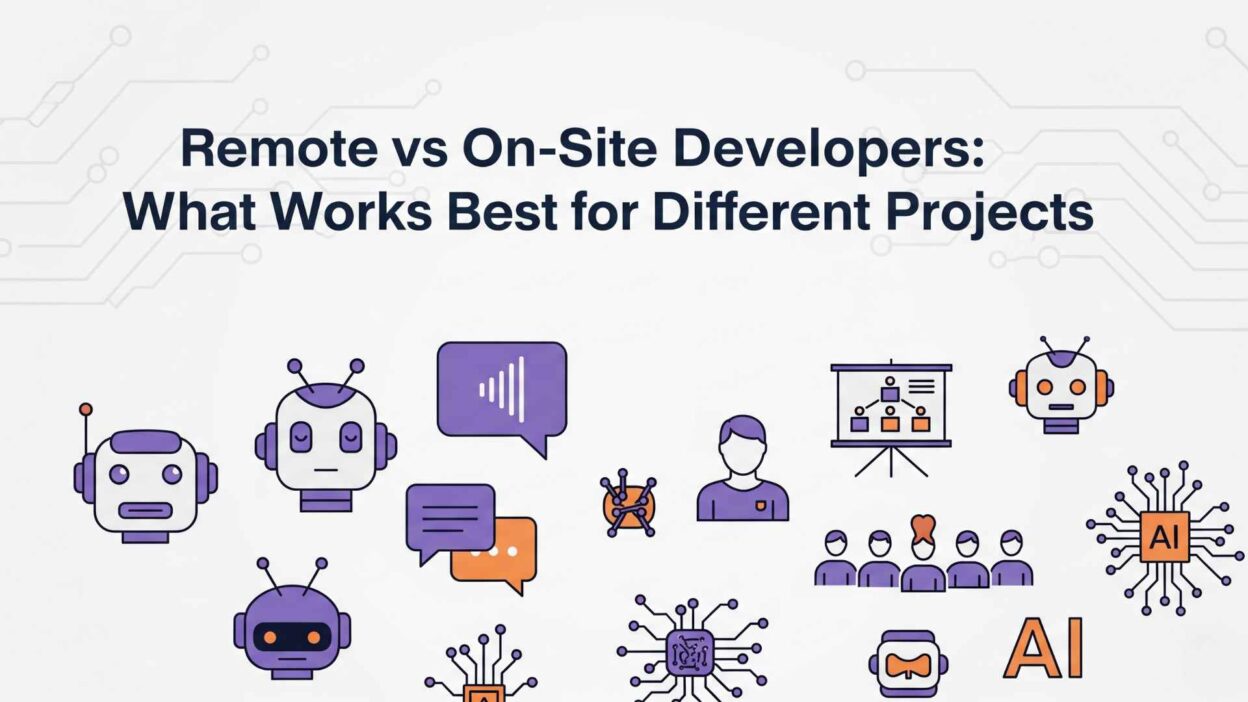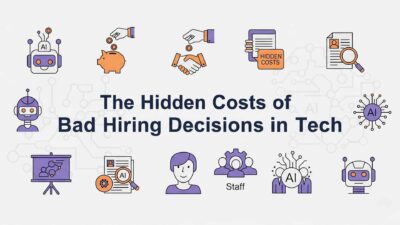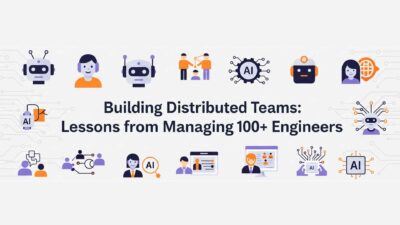TL;DR: The choice between remote vs on-site developers depends on project complexity, collaboration needs, security requirements, and team dynamics. Remote developers excel for cost-effective scaling, specialized skills, and flexible workloads, while on-site developers perform better for real-time collaboration, complex integrations, and security-sensitive projects. Smart companies use a hybrid approach, matching developer placement to project requirements rather than following a one-size-fits-all strategy.
The debate between remote vs on-site developers has evolved from a simple cost consideration to a strategic decision that can make or break project success. With remote work becoming mainstream and companies reporting 30-50% cost savings through strategic remote hiring, the question is no longer whether to go remote, but when and how to implement each model effectively.
Understanding which development approach works best for specific project types can mean the difference between delivering exceptional results and facing costly delays, communication breakdowns, and quality issues. Let’s explore the data-driven insights that help companies make informed decisions about developer placement strategies.
Table of Contents
Understanding the Remote vs On-Site Developer Landscape
The Current State of Developer Work Models
The landscape has shifted dramatically, with remote developers now representing over 40% of the software development workforce. However, this doesn’t mean remote is always the optimal choice. Each model offers distinct advantages that align with different project characteristics and business objectives.
Remote Developer Model:
- Global talent access: Unlimited geographical hiring range
- Cost optimization: 40-70% salary savings depending on location
- Scalability: Easy team expansion without office space constraints
- Productivity gains: 20-25% higher output due to reduced commuting and distractions
On-Site Developer Model:
- Real-time collaboration: Immediate communication and problem-solving
- Direct supervision: Enhanced project monitoring and quality control
- Team cohesion: Stronger company culture and shared experiences
- Resource access: Immediate availability of high-speed internet and specialized hardware
Project Types That Favor Remote Developers
1. Long-Term Development Projects
Remote developers excel in projects with extended timelines and well-defined requirements. The asynchronous nature of remote work actually benefits projects that require deep focus and sustained development effort.
Optimal Project Characteristics:
- Duration: 6+ months with stable requirements
- Complexity: Moderate to high technical complexity
- Team size: 3-8 developers with clear role definitions
- Documentation: Well-documented APIs and technical specifications
Examples:
- SaaS platform development: Multi-month projects with iterative releases
- E-commerce platforms: Complex integrations with payment and inventory systems
- Content management systems: Long-term development with AI integration
- Mobile applications: Cross-platform development with specialized expertise
Success Factors:
- Clear project specifications and acceptance criteria
- Regular milestone reviews and progress tracking
- Asynchronous communication protocols established
- Automated testing and deployment pipelines in place
2. Specialized Technical Projects
When projects require niche expertise that’s difficult to find locally, remote developers provide access to global talent pools with specialized skills.
Technical Specializations:
- Blockchain development: Smart contracts and decentralized applications
- AI/Machine learning: Custom recommendation systems and data analysis
- DevOps automation: Cloud infrastructure and CI/CD pipeline development
- Security implementations: Encryption, authentication, and compliance systems
Cost-Benefit Analysis:
- Local specialist: $150k-$200k annually
- Remote specialist: $60k-$120k annually (40-50% savings)
- Additional benefits: Access to cutting-edge expertise without relocation costs
3. Maintenance and Support Projects
Remote developers are particularly effective for ongoing maintenance, bug fixes, and incremental feature additions where immediate collaboration isn’t critical.
Project Characteristics:
- Predictable workload: Regular updates and maintenance cycles
- Well-documented codebase: Existing systems with comprehensive documentation
- Clear issue tracking: Defined processes for bug reporting and resolution
- Flexible scheduling: Work that can be completed across different time zones
Implementation Strategy:
- Establish clear SLAs for response times and resolution
- Use ticketing systems for organized issue management
- Implement automated monitoring for proactive maintenance
- Create detailed handoff documentation for knowledge transfer
Project Types That Favor On-Site Developers
1. High-Complexity Integration Projects
Projects requiring extensive system integration, real-time collaboration, and immediate problem-solving benefit significantly from on-site developer teams.
Complex Integration Scenarios:
- Enterprise system migrations: Legacy system modernization with multiple stakeholders
- Real-time trading platforms: Low-latency requirements with immediate troubleshooting needs
- Healthcare systems: HIPAA compliance with complex workflow integrations
- Financial services: Regulatory compliance with secure development environments
Why On-Site Works Better:
- Immediate consultation: Real-time discussions with subject matter experts
- Rapid iteration: Quick pivots based on stakeholder feedback
- Security compliance: Controlled access to sensitive systems and data
- Cross-team coordination: Seamless communication with business analysts and architects
2. Time-Sensitive MVP Development
When speed to market is critical and requirements may evolve rapidly, on-site teams provide the agility needed for successful MVP launches.
MVP Project Requirements:
- Tight deadlines: 2-4 month launch windows
- Evolving requirements: User feedback driving rapid changes
- Stakeholder involvement: Regular demos and feedback sessions
- Market validation: Quick pivots based on early user testing
On-Site Advantages:
- Daily standups: Face-to-face progress updates and blocker resolution
- Rapid prototyping: Quick mockups and immediate stakeholder review
- Real-time decision making: Instant collaboration on feature prioritization
- Cultural alignment: Shared understanding of company vision and values
3. Security-Critical Projects
Projects involving sensitive data, financial transactions, or proprietary algorithms often require the controlled environment that on-site development provides.
Security-Sensitive Project Types:
- Financial trading systems: Real-time transaction processing with strict security requirements
- Healthcare applications: Patient data with HIPAA compliance needs
- Government contracts: Security clearance and controlled access requirements
- Proprietary algorithm development: Intellectual property protection needs
Security Benefits:
- Controlled access: Physical security measures and monitored environments
- Network security: Isolated development networks with enterprise-grade protection
- Data sovereignty: Sensitive information remains within company premises
- Compliance auditing: Easier regulatory compliance and audit trails
Hybrid Approaches: The Best of Both Worlds
Strategic Team Composition
The most successful companies don’t choose between remote vs on-site developers—they strategically combine both approaches based on project phases and requirements.
Effective Hybrid Models:
Core + Flex Model:
- On-site core team: 2-3 senior developers for architecture and coordination
- Remote specialists: 3-5 developers for specific technical implementations
- Flexible scaling: Additional remote developers for peak workload periods
Phase-Based Approach:
- Discovery phase: On-site team for requirements gathering and planning
- Development phase: Mixed team with remote developers for implementation
- Integration phase: On-site focus for system integration and testing
- Maintenance phase: Remote team for ongoing support and updates
Geographic Distribution Strategy:
- Primary hub: On-site team in main business location
- Secondary hubs: Remote teams in strategic time zones for 24/7 development
- Specialist locations: Remote experts in specific technology centers
Cost-Benefit Analysis Framework
Quantitative Comparison Metrics
Making data-driven decisions about remote vs on-site developers requires comprehensive cost analysis that goes beyond simple salary comparisons.
Total Cost Comparison:
| Cost Category | On-Site Developer | Remote Developer | Savings |
|---|---|---|---|
| Base Salary | $120,000 | $75,000 | 37.5% |
| Benefits & Overhead | $42,000 (35%) | $18,750 (25%) | 55% |
| Office Space | $6,000 | $1,200 (home office) | 80% |
| Equipment | $3,000 | $2,000 | 33% |
| Recruitment | $20,000 | $10,000 | 50% |
| Annual Total | $191,000 | $106,950 | 44% |
Quality and Productivity Metrics:
Remote Developer Advantages:
- Higher productivity: 20-25% increase due to fewer interruptions
- Lower turnover: 25% reduction in attrition rates
- Extended work hours: Natural time zone coverage for global projects
- Specialized expertise: Access to niche skills regardless of location
On-Site Developer Advantages:
- Faster onboarding: 40% shorter time to productivity
- Better collaboration: 60% faster problem resolution in complex projects
- Cultural integration: Stronger alignment with company values and processes
- Knowledge transfer: 50% more effective mentorship and training
Industry-Specific Recommendations
Technology Startups
Optimal Strategy: Hybrid model with on-site core team and remote specialists
Rationale:
- Limited budget requiring cost optimization through remote talent
- Need for rapid iteration favoring on-site collaboration
- Access to specialized skills through global remote hiring
- Scalability requirements as the company grows
Implementation:
- Start with 2-3 on-site senior developers
- Add remote developers for specific technical areas
- Establish strong documentation and communication protocols
- Scale remote team based on funding and growth needs
Enterprise Software Companies
Optimal Strategy: Project-based approach with security considerations
Rationale:
- Complex integration requirements favoring on-site coordination
- Security and compliance needs requiring controlled environments
- Large-scale projects benefiting from dedicated team structures
- Budget flexibility allowing for strategic talent investment
Implementation:
- On-site teams for security-critical components
- Remote teams for standard development work
- Hybrid approach for large-scale projects
- Strong governance and project management frameworks
E-commerce and Digital Agencies
Optimal Strategy: Remote-first with on-site coordination roles
Rationale:
- Cost pressure from competitive markets
- Diverse technical requirements needing specialized skills
- Scalable workload requiring flexible team structures
- Global client base benefiting from distributed teams
Implementation:
- Remote developers for front-end, back-end, and specialized work
- On-site project managers and client relationship roles
- Flexible team composition based on project requirements
- Strong client communication and project tracking systems
Communication and Collaboration Strategies
Remote Team Best Practices
Successful remote development teams require structured communication protocols and collaboration frameworks that compensate for the lack of physical presence.
Essential Communication Tools:
- Daily standups: Video conferences with screen sharing for progress updates
- Asynchronous updates: Written progress reports and documentation
- Code reviews: Systematic peer review processes with detailed feedback
- Virtual pair programming: Screen sharing sessions for complex problem solving
Collaboration Framework:
- Overlap hours: Minimum 4-hour daily overlap for real-time communication
- Documentation standards: Comprehensive technical and process documentation
- Regular retrospectives: Weekly or bi-weekly team improvement sessions
- Virtual team building: Online social events and informal communication channels
On-Site Team Optimization
On-site teams benefit from structured in-person collaboration while avoiding the pitfalls of constant interruption and meeting overload.
Effective On-Site Practices:
- Dedicated focus time: Protected hours for deep development work
- Structured meetings: Time-boxed discussions with clear agendas
- Open collaboration spaces: Areas designed for spontaneous problem-solving
- Cross-functional integration: Regular interaction with business stakeholders
Risk Management and Quality Assurance
Remote Development Risks and Mitigation
Communication Barriers:
- Risk: Delayed issue resolution due to asynchronous communication
- Mitigation: Structured escalation procedures and overlap hour requirements
- Monitoring: Regular communication effectiveness assessments
Quality Control:
- Risk: Reduced oversight leading to code quality issues
- Mitigation: Automated testing pipelines and comprehensive code review processes
- Monitoring: Code quality metrics and automated analysis tools
Security Concerns:
- Risk: Data exposure through unsecured home networks
- Mitigation: VPN requirements, secure development environments, and security training
- Monitoring: Regular security audits and compliance checks
On-Site Development Risks and Mitigation
Higher Costs:
- Risk: Budget overruns due to higher overhead costs
- Mitigation: Careful team size planning and hybrid model implementation
- Monitoring: Regular cost-benefit analysis and ROI measurement
Limited Talent Pool:
- Risk: Inability to find specialized skills in local market
- Mitigation: Strategic remote hiring for specialized roles
- Monitoring: Skills gap analysis and talent pipeline development
Future Trends and Considerations
Emerging Hybrid Models
The future of software development teams lies in sophisticated hybrid approaches that leverage the strengths of both remote and on-site models while mitigating their respective weaknesses.
AI-Enhanced Collaboration:
- Smart scheduling: AI-powered coordination across time zones
- Automated documentation: AI-generated technical documentation and code comments
- Predictive project management: Machine learning-based risk assessment and resource allocation
Virtual Reality Collaboration:
- Immersive meetings: VR-based collaborative sessions for complex problem solving
- Virtual pair programming: Enhanced remote collaboration through VR environments
- Spatial team building: Virtual team spaces for informal interaction
Outcome-Based Hiring:
- Skills over location: Focus on capabilities rather than geographic proximity
- Project-specific teams: Dynamic team formation based on project requirements
- Performance-driven retention: Results-based career progression regardless of work location
Making the right choice between remote vs on-site developers requires a nuanced understanding of project requirements, team dynamics, and business objectives. The most successful companies don’t view this as an either/or decision, but as a strategic opportunity to optimize team composition for each specific situation.
Remote developers excel in projects requiring specialized expertise, cost optimization, and flexible scaling. They’re ideal for long-term development projects, maintenance work, and situations where access to global talent pools provides competitive advantages.
On-site developers perform best in complex integration projects, time-sensitive MVP development, and security-critical applications. They provide the real-time collaboration and immediate problem-solving capabilities essential for certain project types.
The key to success lies in matching developer placement strategies to project characteristics rather than adopting a one-size-fits-all approach. Companies that master this strategic alignment achieve 30-50% cost reductions while maintaining or improving project quality and delivery speed.
As the software development landscape continues evolving, the most competitive organizations will be those that leverage both remote and on-site capabilities strategically, creating flexible, efficient, and high-performing development teams that adapt to changing project needs and market demands.
📧 Email: [email protected]
📞 Phone: 1-347-543-4290
🌐 Website: emasterlabs.com
📍 Address: 1942 Broadway Suite 314 Boulder, CO 80302 USA
Engineer Master Labs – You Think, We Automate, You Profit





